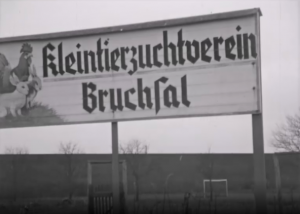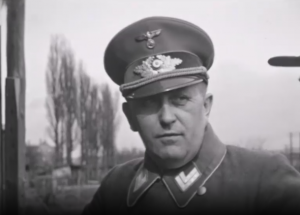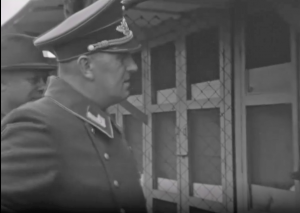Besuch Staatsrat Spaniol (LFS 00462 2) : Différence entre versions
| Ligne 1 : | Ligne 1 : | ||
| − | {FicheSequence | + | {{FicheSequence |
|titreCree=Non | |titreCree=Non | ||
|titre=Besuch Staatsrat Spaniol | |titre=Besuch Staatsrat Spaniol | ||
| Ligne 37 : | Ligne 37 : | ||
Elaine Kohler | Elaine Kohler | ||
| + | }} | ||
Version du 18 février 2021 à 16:29
Contexte et analyse
The one-minute silent film, shot in 16mm format in black and white, shows the visit of State Councilor Spaniol to the Bruchsal small animal breeders on February 28, 1940, as a title reveals. He visits the 'model farm' there following an appearance at a large-scale rally that he had as one of Goebbels' appointed imperial speakers. Since the Bruchsal small animal breeding facility is considered exemplary, his visit should come as no surprise. It is conceivable that he will want to speak about this example at upcoming events. At the beginning, in uniform, he looks at the large entrance sign to the 'Bruchsal Small Animal Breeding Association' with images of two rabbits and a rooster. In the background you can see barren fields and some of the club stables. Then Spaniol is probably standing with the club's chairman Robert Botterer and a breeder in front of the simply built wooden rabbit stalls. Spaniol seems very interested, especially when the breeder takes one of the rabbits out of the stable and has it examined by him. Spaniol strokes the rabbit extensively and examines its thick white fur. Rabbit wool was then used in clothing production. The three men talk to each other - Spaniol is shown in close-up. Behind the men you can see the 'garden land' that is cultivated by each of the rabbit breeders of the Bruchsal association. Spaniol's visit comes to an end quickly, he walks across the fields back to the car with the driver.
Alois Spaniol's career
Alois Spaniol joined the NSDAP on May 1, 1931. A year later he became NSDAP district leader of Saarlouis-Merzig in the Saar area, which had been occupied by the French since 1920. In July 1933 he was appointed regional leader of the new NSDAP in the Saar area. He held this post until March 1935, when the Saar area was re-annexed to the German Reich. Spaniol was often used for National Socialist propaganda purposes, including as head of the 'German Front'. As a mass movement, this was to unite the various national parties that were dissolved in the Saarland NSDAP in 1935 after the 'Anschluss'. He also published Nazi propaganda publications such as the 'Deutsche Front' and the 'Saarfront'. In 1935 Spaniol accepted the office of Mayor of Andernach, which he officially held for ten years. As a good speaker, Spaniol was appointed as a so-called 'Reichs speaker' from 1936 by Propaganda Minister Joseph Goebbels. In the course of the Second World War, Spaniol was active in the Wehrmacht's military service and continued to be active for propaganda purposes, for example in various theaters of war.
Small animal breeding as food security
The breeding of small animals and especially the German rabbit breeding had experienced a great upswing since the National Socialist takeover. With a new objective and the creation of general principles for breeding and keeping the animals, they grew into an important economic factor. In the "Swabian Small Animal Breeder", a weekly newsletter, on November 24, 1938, an article with the heading "Party promotes small animal breeding" appeared on the title page. It describes the breeding of small animals in the Bruchsal district as one of the most important economic bases in the district. In 1936 the establishment of a small animal breeding farm had started there. A clean, exemplary facility was created from a former rubble dump, in which the local small animal breeders owned their stables and also managed a share of garden land. According to the article, Bruchsal has created a true model farm with this location, a “place of exemplary breeding and order”, which has been of great economic benefit since its inception and which also conveys values that would only arise if small animal breeding was carried out in an economically rational and uniform manner . The Bruchsal plant shows that with good will, even under the worst conditions, a piece of work can be done for the people's “freedom of bread”. This was only possible with the generous support and support of the NSDAP and the Bruchsal city administration. This is justified in particular with the establishment of small animal breeding according to the guidelines of the so-called four-year plan. On October 18, 1936, with the ordinance for the implementation of the four-year plan, Adolf Hitler gave Hermann Göring the general power to direct all economic measures that were necessary to achieve military capability. The primary goal was the self-sufficiency and war ability of the German Reich, including the safeguarding of 'food freedom'. Because "the soldier who has to eat the bread of the enemy" lost the battle before it began. Nobody experienced this worse than the German people. The breeding of small animals contributes to the food security of the people and opens a new section of the work in the field of nutrition policy in the Bruchsal district. For this reason, small animal breeding should be tightly organized and promoted in all communities. Spaniol's visit and the film document underline the importance of small animal breeding for these larger political goals.
Elaine KohlerPersonnages identifiés
Lieux ou monuments
- ↑ Cette fiche est en cours de rédaction. À ce titre elle peut être inachevée et contenir des erreurs.








